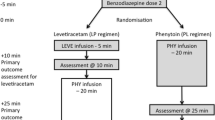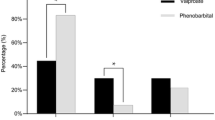Abstract
Objective
To compare the efficacy of phenytoin, valproate, and levetiracetam in the management of pediatric convulsive status epilepticus.
Design
Randomized double-blind controlled clinical trial.
Setting
Pediatric critical care division in a tertiary care institute from June, 2016 to December, 2018.
Participants
110 children aged three month to 12 year with convulsive status epilepticus.
Intervention
Patients not responding to 0.1 mg/kg intravenous lorazepam were randomly assigned (1:1:1) to receive 20 mg/kg of phenytoin (n=35) or valproate (n=35) or levetiracetam (n=32) over 20 minutes. Patients with nonconvulsive status epilepticus, recent hemorrhage, platelet count less than 50,000 or International normalized ratio (INR) more than 2, head injury or neurosurgery in the past one-month, liver or kidney disease, suspected or known neurometabolic or mitochondrial disorders or structural malformations, and allergy to study drugs; and those who were already on any one of the study drugs for more than one month or had received one of the study drugs for current episode, were excluded.
Outcome measure
The primary outcome was the proportion of patients that achieved control of convulsive status epilepticus at the end of 15 minutes after completion of the study drug infusion. Secondary outcomes were time to control of seizure, rate of adverse events, and the requirement of additional drugs to control seizure, length of ventilation, hospital stay, and functional status after three months (Glasgow Outcome Scale).
Results
The study was stopped after the planned mid-interim analysis for futility. Intention to treat analysis was done. There was no difference in primary outcome in phenytoin (31/35, 89%), valproate (29/35, 83%), and levetiracetam (30/32, 94%) (P=0.38) groups. There were no differences between the groups for secondary outcomes. One patient in the phenytoin group had a fluid-responsive shock, and one patient in the valproate group died due to encephalopathy and refractory shock.
Conclusions
Phenytoin, valproate, and levetiracetam were equally effective in controlling pediatric convulsive status epilepticus.
Similar content being viewed by others
References
Lyttle MD, Rainford NEA, Gamble C, Messahel S, Humphreys A, Hickey H, et al. Levetiracetam versus phenytoin for second-line treatment of paediatric convulsive status epilepticus (EcLiPSE): A multicentre, open-label, randomised trial. Lancet. 2019;393:2125–34.
Gulati S, Kalra V, Sridhar MR. Status epilepticus in Indian children in a tertiary care center. Indian J Pediatr. 2005;72:105–8.
McTague A, Martland T, Appleton R. Drug management for acute tonic-clonic convulsions including convulsive status epilepticus in children. Cochrane Database Syst Rev. 2018;1:CD001905.
Verrotti A, Ambrosi M, Pavone P, Striano P. Pediatric status epilepticus: Improved management with new drug therapies? Expert Opin Pharmacother. 2017;18:789–98.
Trinka E, Kälviäinen R. 25 years of advances in the definition, classification and treatment of status epilepticus. Seizure. 2017;44:65–73.
Trinka E, Cock H, Hesdorffer D, Rossetti AO, Scheffer IE, Shinnar S, et al. A Definition and Classification of Status Eepilepticus–Report of the ILAE Task Force on Classification of Status Epilepticus. Epilepsia. 2015;56:1515–23.
Brigo F, Sartori S. The new definition and classification of status epilepticus: What are the implications for children? Epilepsia. 2016;57:1942–3.
Mundlamuri RC, Sinha S, Subbakrishna DK, Prathyusha PV, Nagappa M, Bindu PS, et al. Management of generalised convulsive status epilepticus (SE): A prospective randomised controlled study of combined treatment with intravenous lorazepam with either phenytoin, sodium valproate or levetiracetam—Pilot study. Epilepsy Res 2015; 114:52–8.
Kapur J, Elm J, Chamberlain JM, Barsan W, Cloyd J, Lowenstein D, et al. Randomized trial of three anticonvulsant medications for status epilepticus. N Engl J Med. 2019;381:2103–13.
Dalziel SR, Borland ML, Furyk J, Bonisch M, Neutze J, Donath S, et al. Levetiracetam versus phenytoin for second-line treatment of convulsive status epilepticus in children (ConSEPT): an open-label, multicentre, randomised controlled trial. Lancet 2019;393:2135–45.
Ýþgüder R, Güzel O, Ceylan G, Yýlmaz Ü, Aðýn H. A comparison of intravenous levetiracetam and valproate for the treatment of refractory status epilepticus in children. J Child Neurol. 2016;31:1120–6.
Yasiry Z, Shorvon SD. The relative effectiveness of five antiepileptic drugs in treatment of benzodiazepine-resistant convulsive status epilepticus: a meta-analysis of published studies. Seizure. 2014;23:167–74.
Brigo F, Bragazzi N, Nardone R, Trinka E. Direct and indirect comparison meta-analysis of levetiracetam versus phenytoin or valproate for convulsive status epilepticus. Epilepsy Behav. 2016;64:110–5.
Mehta V, Singhi P, Singhi S. Intravenous sodium valproate versus diazepam infusion for the control of refractory status epilepticus in children: A randomized controlled trial. J Child Neurol. 2007;22:1191–7.
Mishra D, Sharma S, Sankhyan N, Konanki R, Kamate M, Kanhere S, et al. Consensus guidelines on management of childhood convulsive status epilepticus. Indian Pediatr. 2014;51:975–90.
Dawrant J, Pacaud D. Pediatric hypocalcemia: making the diagnosis. CMAJ. 2007;177:1494–7.
Acknowledgments
S Raja Deepa, JIPMER Campus, Puducherry, India for review and editing of the manuscript; Mr Rakesh Mohindra, Punjab University, Chandigarh, India. Mrs Thenmozhi M for helping with statistical analysis and Mrs. Harpreet Kaur, Punjab University, Chandigarh, India, Mrs. Neelima Chadha (Tulsi Das Library, PGIMER, Chandigarh, India) for helping with medical literature search.
Author information
Authors and Affiliations
Corresponding author
Additional information
Contributors: VV,RR,SM: Management of the patients and study supervision. VV: collected the data, reviewed the literature and drafted the first manuscript: SM: contributed for protocol development, review of literature and manuscript. RR: conceptualized the study, reviewed the literature and critically reviewed the manuscript. All authors approved the final version of the manuscript. RR: is the guarantor of the paper.
Funding: In part by the institutional and departmental fund
Competing interest: None stated.
Rights and permissions
About this article
Cite this article
Vignesh, V., Rameshkumar, R. & Mahadevan, S. Comparison of Phenytoin, Valproate and Levetiracetam in Pediatric Convulsive Status Epilepticus: A Randomized Double-blind Controlled Clinical Trial. Indian Pediatr 57, 222–227 (2020). https://doi.org/10.1007/s13312-020-1755-4
Received:
Revised:
Accepted:
Published:
Issue Date:
DOI: https://doi.org/10.1007/s13312-020-1755-4




